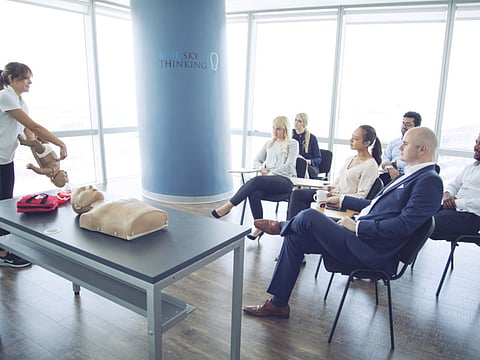When first aid becomes the last priority
Concern as several homes and workplaces are found to be lacking awareness, basic tools and skills to respond in a medical emergency

Dubai: A Bangladeshi housewife in Al Qusais is in the kitchen when hot oil from a pan accidentally spills on her lower limbs. She is in great pain but as she waits for the ambulance to arrive, she applies some toothpaste on the burnt areas. By the time she arrives at the Rashid Hospital Trauma Centre, her condition has worsened.
Elsewhere, a German expat walking past the reception at his Deira office suddenly collapses. He hits himself on the desk as he falls.
"Over 60 per cent of the 350-500 cases we receive everyday are trauma-related."
Those around have no clue what to do. He is brought to Rashid Hospital, where it emerges that he not only suffered heat exhaustion, but also a dislocated elbow which could have been avoided had due care been taken when he fell.
“Over 60 per cent of the 350-500 cases we receive everyday at Rashid Hospital are trauma-related, but there is a lot that can be done to bring immediate relief to patients if proper first aid is administered,” said Dr G.Y. Naroo, consultant, emergency medicine at the Trauma Centre.
Rebecca Smith, founder of Safe Hands, a first aid training initiative, said, “The sad reality is that accidents happen and are often out of our control. What is within our control is our response to the situation. But most people don’t have the tools to deal with an emergency.”
She said though some are first aid trained, they cannot implement their skills. It could be a case of not having a first aid kit at hand at home or knowing where the automatic external defibrillator (AED) is located at the office.
Look for the ‘four Bs’
According to Dr Naroo, there are ‘four Bs’ that must be addressed in an emergency: the patient’s breathing, bleeding, burns and bones.
“Look for these four Bs. First aid teaches us how to clear the patient’s airway if he is not breathing properly, If there’s bleeding, take sterile gauze from the first aid kit and put pressure on the wound; if there’s a burn, apply cold water; if the patient has fallen and hit himself, bring him into a correct position. First aid teaches you how you can do this.” But often, complacence holds people back from knowing what they need to know.
Smith said, “In many workplaces we’ve visited, we have found people are unaware of their company’s health and safety guidelines, including allocated first aid officers, location of first aid kits, nearest hospitals and ambulance sites and in some cases, even the emergency services number.”
Lack of awareness
The large majority of companies were also found to be unaware of employees’ existing health conditions. “For example, information about allergies and the immediate use of epipens, medications that employees may be on, next of kin and or any other pre-existing health conditions is lacking.”
On the home front, while some parents are first aid trained, children are often left in the care of nannies and maids who are not. “We have seen first hand significant injuries which have occurred whilst children have been left in the care of untrained nannies,” said Smith.
While well-equipped first aid kits are a must have, it is also essential to replenish them every six months, Epipens to deal with allergy cases are also a must-keep in these kits.
What should a first aid kit contain?
Bandage, triangular bandage, sting relief pad, cleaning wipe, scissors, tweezers, disposable CPR mask (one-way valve), adhesive bandage, sterile non-woven swab, trauma pad, alcohol wipe, pencil, non-woven medical tape, disposable gloves, safety pins, guidance book, face shield, epipen and a list of emergency numbers.
Workplaces are also required to keep an automated external defibrillator (AED).
Sign up for the Daily Briefing
Get the latest news and updates straight to your inbox


